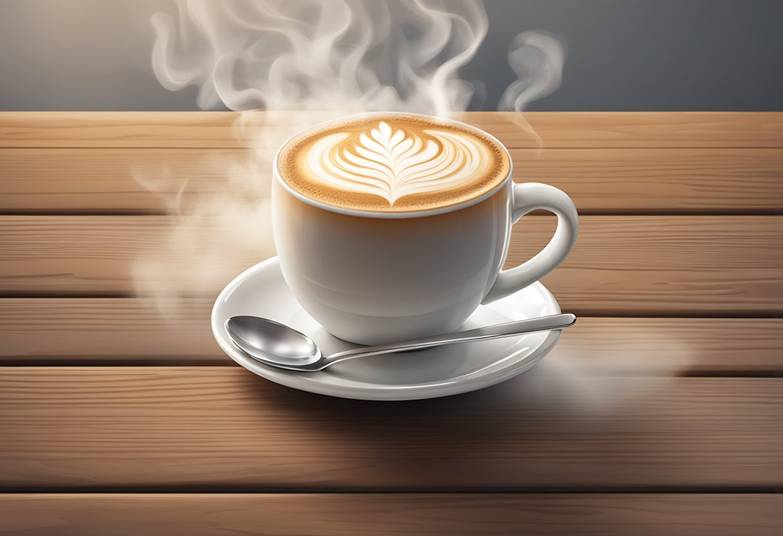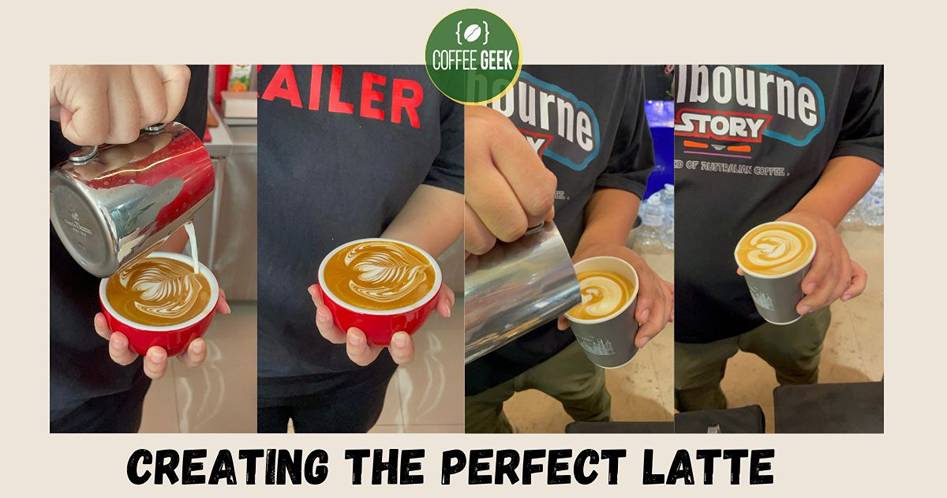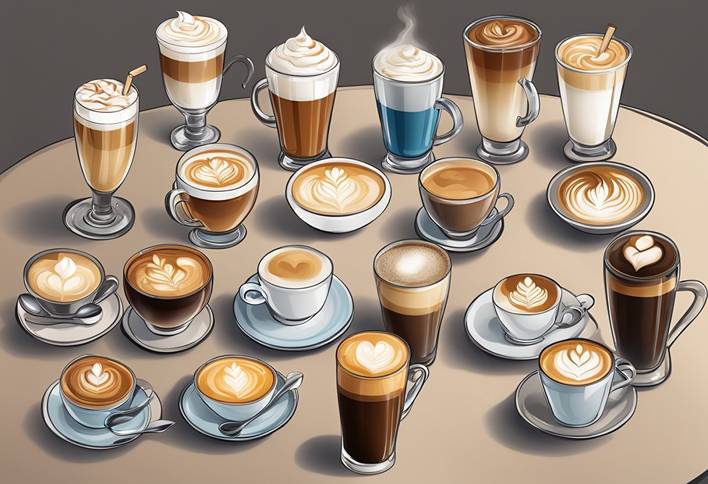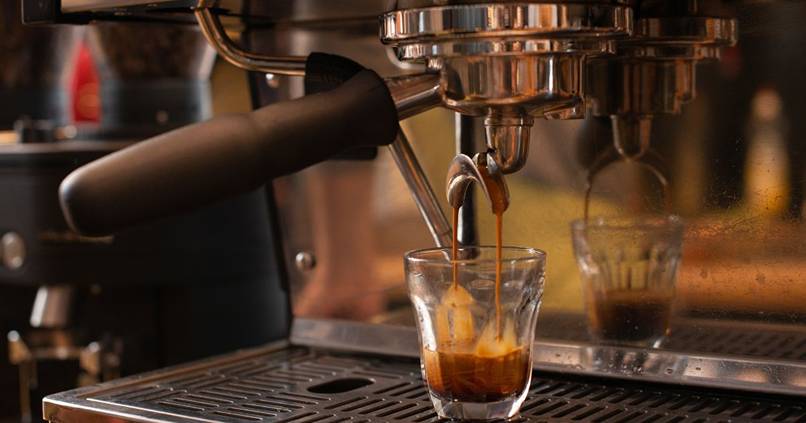Lattes have been a staple in the world of coffee for quite some time, and their popularity has only increased over the years.
As a coffee enthusiast, you might find yourself wondering, are lattes hot or cold?
The answer to this question lies in the origins of the drink and the various ways it has evolved over time.

Latte is traditionally served hot with steamed milk and espresso, creating a rich and comforting beverage that can brighten even the gloomiest of days.
However, iced lattes have gained popularity in recent years, offering a refreshing alternative to their hot counterpart.
No matter your preference, both hot and cold lattes provide endless possibilities for customization and variations in flavor, allowing for a personalized coffee experience.
Key Takeaways
- Lattes can be both hot and cold, depending on your preference
- Traditional lattes are served hot, but to serve lattes iced have become increasingly popular
- Both hot and cold lattes offer numerous flavor variations and customizable options
Are Lattes Hot or Cold?

What Is a Latte?
A latte, short for caffè latte, is a popular coffee drink made with a combination of espresso and steamed milk.
You may often find it topped with a bit of milk foam to enhance its taste and presentation.
Many coffee enthusiasts love lattes because they offer a perfect balance between the bold flavor of espresso and the creamy texture of steamed milk.
Hot Lattes
Hot lattes, as the name suggests, are served hot and can provide a sense of warmth and comfort.
They are typically made by pouring a shot of espresso into a cup and then adding steamed milk to create a creamy layer.

Finally, a spoonful of milk foam is placed on top to complete the drink.
Enjoying a hot latte during colder months or on a chilly day can be a delightful experience that warms you from the inside out.
It’s the most common way lattes are served and preferred for their ability to soothe your soul.
Cold Lattes
On the other hand, cold lattes, also known as iced lattes, are perfect for when you want a refreshing coffee treat.
Instead of using steamed milk, the latte is made with cold milk to give it a cooler temperature.
Some people even add ice to their iced lattes, making them even chillier and more invigorating on a hot summer’s day.
In conclusion, lattes can be served either hot or cold, catering to different moods and weather conditions.

Hot lattes bring warmth and comfort while cold lattes offer a refreshing alternative.
No matter how you like your latte, it’s the perfect coffee drink to satisfy your cravings and give you that needed boost of energy during your day.
So whether it’s a frosty morning or a scorching afternoon, go ahead and indulge in your favorite version of this beloved espresso-based delight.
Creating the Perfect Latte

Milk and Espresso Balance
To create the perfect latte, it’s important to find the right balance between milk and espresso.
The typical ratio for a latte is 1:3, meaning one part espresso to three parts milk.
The milk should be steamed to create a creamy microfoam, with a perfect temperature between 150°F to 155°F (65°C to 68°C).
- Espresso shot: Use a freshly brewed shot of espresso with a rich crema on top. The crema is an essential element of a latte, as it adds depth to the flavor.
- Milk: Choose whole milk for a creamier texture and smoother microfoam. Remember to heat it to the right temperature for a balanced final result.
Latte Art and Presentation
A key aspect of serving a perfect latte is the art and presentation.
Latte art is created by skillfully pouring the microfoam into the espresso, forming intricate patterns or designs.
The contrast between the dark espresso and the white milk foam produces visually appealing layers.
- Microfoam: Ensure your steamed milk has a velvety microfoam consistency. Practice swirling and tapping the milk jug before pouring.
- Pouring technique: Gently and steadily pour the microfoam into the espresso, starting from a higher distance and gradually lowering the jug as you create the design.
Flavoring and Additives
A latte can be made personalized and enhanced by adding a variety of flavors and sweeteners:
- Syrups: Popular options include caramel, vanilla, hazelnut, and seasonal favorites like pumpkin spice. Use a moderate amount to avoid overpowering the natural flavors of the espresso and milk.
- Sugar or sweeteners: For those who prefer a sweeter taste, add sugar or sweeteners such as stevia or agave to your latte.
- Spices: Sprinkle cinnamon or other spices on top of the milk foam for a subtle hint of flavor and an attractive finish.
Remember, the key to creating the perfect latte is balancing the flavors, temperature, and presentation.
By refining your milk and espresso ratio, practicing your latte art and presentation skills, and experimenting with different flavors and sweeteners, you can create a delightful and enjoyable latte tailored to your taste buds.
Variations of Lattes
Lattes are a popular espresso-based drink that can be served hot or cold.
They come in a variety of flavors and can be customized to suit your personal preferences.
In this section, we’ll explore some of the variations in milk options, hot and cold preferences, and seasonal and specialty lattes.

Different Types of Milk
The type of milk used in a latte can greatly influence its taste and texture.
Traditional dairy milk creates a creamy, rich beverage, with the steamed milk producing a silky foam on top.

However, there are also numerous milk alternatives available to cater to different dietary needs and preferences.
Some popular choices include:
- Almond milk: Nutty flavor, slightly lighter foam
- Soy milk: Creamy and mild, with a good foam consistency
- Coconut milk: Sweet and tropical, with a lighter foam
- Oat milk: Creamy and naturally sweet, with a rich foam
Each milk option lends a unique flavor and texture to your latte, so don’t hesitate to experiment with different types to find your perfect match.
Hot vs. Cold Preferences
Lattes can be enjoyed both hot and cold, depending on your preferences and the occasion.
A hot latte typically consists of espresso with steamed milk, which creates a comforting and rich beverage.
On the other hand, an iced latte combines espresso with cold milk and ice, offering a refreshing drink during warm weather.
If you can’t decide between a hot or cold latte, why not try a “warm” latte?
This option is simply a latte that’s been heated to a lower temperature than a traditional hot latte, offering a middle ground between the two extremes.
Seasonal and Specialty Lattes
In addition to classic hot & iced lattes, there are numerous seasonal and specialty lattes that feature unique flavors and creative twists.
Some popular examples include:
- Pumpkin Spice Latte: A fall favorite, this latte incorporates pumpkin puree, spices, and whipped cream for a cozy, comforting treat.
- Caramel Macchiato: A sweet indulgence, this drink combines espresso, steamed milk, and caramel syrup, often with a drizzle of caramel on top.
- Mocha: For chocolate lovers, a mocha blends espresso with chocolate syrup and steamed milk, sometimes topped with whipped cream or cocoa powder.
As you explore the world of lattes, feel free to personalize your drinks with additional flavorings, milk alternatives, and garnishes to create your own unique combinations.
Latte Making Techniques

Brewing the Espresso
As a barista, your espresso brewing skills will be the foundation for creating delicious hot and cold lattes. Start by measuring one or two shots of espresso depending on your preference.
Make sure your espresso machine is properly calibrated and at the right temperature for optimal extraction.
Remember, a good espresso shot should have a rich crema on top that distinguishes it from other espresso drinks.

Frothing the Milk
Next, let’s talk about frothing the milk for your delicious latte. The texture of your milk will have a significant impact on the taste and mouthfeel of the final drink. When frothing, aim to create a silky, smooth microfoam.
Here’s a brief guide on getting the perfect froth:
- Start with cold milk.
- Use a steam wand at an angle, just below the milk’s surface.
- Gradually raise the steam wand to incorporate air and create a uniform foam.
- Stop steaming when the milk reaches the perfect temperature (around 150°F for a hot latte) and the desired milk texture.
Temperature and Texture
The temperature of your latte makes a big difference in the overall taste and experience.
The perfect temperature for a hot latte is usually around 150°F, but some people might prefer an extra-hot version, which could go up to 160°F.
On the other hand, cold lattes require ice and colder milk to achieve their refreshing taste.
To summarize, when you make a latte, whether hot or cold, focus on brewing a great espresso, frothing the milk to the perfect texture, and adjusting the temperature according to individual preferences.
Remember, practice makes perfect, so keep experimenting and refining your technique to become a true latte master, cause finding the best way to make latte is a great way to enjoy lattes!
| Type of Latte | Temperature |
|---|---|
| Hot Latte | Hot |
| Iced Latte | Cold |
| Cold Brew Latte | Cold |
| Frozen Latte | Cold |
| Blended Latte | Cold |
| Caramel Macchiato | Usually Hot |
Final Words
Lattes, a beloved staple in coffee culture, can be enjoyed both hot and cold, catering to diverse preferences and climates.
The latte temperature plays a crucial role in its preparation and enjoyment.
Latte is typically brewed by forcing hot water through coffee grounds, then combined with hot milk to create a delicious, frothy milk top.
The ideal latte temperature, especially for a hot latte, is usually served hot, making it a comforting choice on a cold winter day.
Starbucks, one of the most popular coffee chains, offers a range of Starbucks lattes that can be enjoyed either as a hot or cold beverage.
The best temperature for a latte, particularly when making a hot latte at home, depends largely on personal preference.
However, the ideal temperature for a latte should be hot as possible without scalding the milk, ensuring the perfect balance between temperature and flavor.
On the other hand, an iced latte is a refreshing option on a hot summer day.
An iced latte is made by combining espresso with cold milk and ice, offering a cool alternative without compromising the classic latte taste.
Starbucks lattes, for example, are available as both “hot latte” and “iced latte” options, allowing customers to enjoy their favorite drink regardless of the season.
Making the perfect latte, whether hot or iced, involves mastering the art of frothy milk and understanding the ideal temperature or method to serve a latte.
For those who prefer their latte hot, brewing the espresso and steaming the milk to the right temperature is key. In contrast, an iced latte might require cold milk and the addition of ice cubes.
For coffee drinkers who prefer it cold, an oat milk latte or a latte with three shots of espresso served over ice can be delightful.
The difference between a latte and a cappuccino also lies in the amount and texture of the milk used, with lattes generally having more milk and less foam.
In conclusion, whether you prefer your latte hot or iced, there are numerous latte variations and latte recipes to try.
The type of latte you prefer may depend on the weather, with a hot latte being ideal on a cold day and an iced latte on a hot day.
The latte is one of the most versatile and popular coffee drinks, and understanding, learn how to make the latte, whether you prefer it hot or cold, can enhance your coffee experience.
Frequently Asked Questions

Can lattes be served both hot and iced?
Yes, lattes can also be served both hot and iced.
A traditional latte consists of espresso and steamed milk, while an iced latte includes espresso and cold milk poured over ice.
Both options offer a rich and creamy taste, making it a choice based on your personal preference between hot and cold.
What’s the difference between a hot latte and an iced latte?
The main difference between a hot latte and a refreshing iced latte lies in their temperature and milk preparation.
A hot latte has steamed milk, creating a creamy texture, whereas when you make an iced latte uses cold milk poured over ice, resulting in a more refreshing drink. In both cases, the espresso remains the same.
Are there specific types of lattes that are meant to be served cold?
Though many lattes can be enjoyed either hot or cold, some specific types are more suited to also be served cold, such as flavored lattes with flavors like caramel or vanilla.
These flavors tend to work well with the refreshing nature of an iced latte, making it the preferred method for those particular drinks.
How do I order a latte if I want it cold?
When you’re at a coffee shop, simply specify to the barista that you’d like your latte to be served “iced” or “cold.”
By doing so, you’ll ensure that you receive a refreshing and cold latte instead of the traditional hot version.
Do all coffee shops serve both hot and cold lattes?
Most coffee shops typically offer both hot and cold lattes, as they’re popular choices among customers.
However, there might be instances of smaller or more specialized coffee shops that focus solely on one type of latte or another, so it’s best to check their menu or ask a staff member for their available options.
What is the typical serving temperature for a latte at a cafe?
A hot latte is generally served at a temperature between 150°F and 170°F (65°C and 75°C) to preserve the espresso’s flavor and provide optimal enjoyment.
An iced latte, on the other hand, is served chilled with ice, making its temperature much lower and suitable for a refreshing drink.

